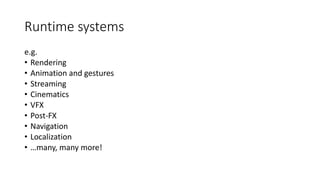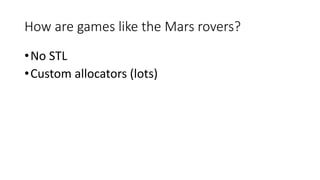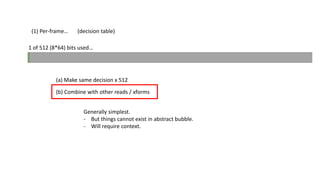Data oriented design and c++
- 1. Data-Oriented Design and C++ Mike Acton Engine Director, Insomniac Games @mike_acton
- 2. A bit of background…
- 3. What does an “Engine” team do?
- 4. Runtime systems e.g. • Rendering • Animation and gestures • Streaming • Cinematics • VFX • Post-FX • Navigation • Localization • …many, many more!
- 5. Development tools e.g. • Level creation • Lighting • Material editing • VFX creation • Animation/state machine editing • Visual scripting • Scene painting • Cinematics creation • …many, many more!
- 6. What’s important to us?
- 7. What’s important to us? • Hard deadlines
- 8. What’s important to us? • Hard deadlines • Soft realtime performance requirements (Soft=33ms)
- 9. What’s important to us? • Hard deadlines • Soft realtime performance requirements (Soft=33ms) • Usability
- 10. What’s important to us? • Hard deadlines • Soft realtime performance requirements (Soft=33ms) • Usability • Performance
- 11. What’s important to us? • Hard deadlines • Soft realtime performance requirements (Soft=33ms) • Usability • Performance • Maintenance
- 12. What’s important to us? • Hard deadlines • Soft realtime performance requirements (Soft=33ms) • Usability • Performance • Maintenance • Debugability
- 13. What languages do we use…?
- 14. What languages do we use…? • C • C++ • Asm • Perl • Javascript • C#
- 15. What languages do we use…? • C • C++ ~70% • Asm • Perl • Javascript • C#
- 16. What languages do we use…? • C • C++ ~70% • Asm • Perl • Javascript • C# • Pixel shaders, vertex shaders, geometry shaders, compute shaders, …
- 17. We don’t make games for Mars but…
- 18. How are games like the Mars rovers?
- 19. How are games like the Mars rovers? •Exceptions
- 20. How are games like the Mars rovers? •Exceptions •Templates
- 21. How are games like the Mars rovers? •Exceptions •Templates • Iostream
- 22. How are games like the Mars rovers? •Exceptions •Templates • Iostream • Multiple inheritance
- 23. How are games like the Mars rovers? •Exceptions •Templates • Iostream • Multiple inheritance •Operator overloading
- 24. How are games like the Mars rovers? •Exceptions •Templates • Iostream • Multiple inheritance •Operator overloading •RTTI
- 25. How are games like the Mars rovers? •No STL
- 26. How are games like the Mars rovers? •No STL •Custom allocators (lots)
- 27. How are games like the Mars rovers? •No STL •Custom allocators (lots) •Custom debugging tools
- 28. Is data-oriented even a thing…?
- 29. Data-Oriented Design Principles The purpose of all programs, and all parts of those programs, is to transform data from one form to another.
- 30. Data-Oriented Design Principles If you don’t understand the data you don’t understand the problem.
- 31. Data-Oriented Design Principles Conversely, understand the problem by understanding the data.
- 32. Data-Oriented Design Principles Different problems require different solutions.
- 33. Data-Oriented Design Principles If you have different data, you have a different problem.
- 34. Data-Oriented Design Principles If you don’t understand the cost of solving the problem, you don’t understand the problem.
- 35. Data-Oriented Design Principles If you don’t understand the hardware, you can’t reason about the cost of solving the problem.
- 36. Data-Oriented Design Principles Everything is a data problem. Including usability, maintenance, debug-ability, etc. Everything.
- 37. Data-Oriented Design Principles Solving problems you probably don’t have creates more problems you definitely do.
- 38. Data-Oriented Design Principles Latency and throughput are only the same in sequential systems.
- 39. Data-Oriented Design Principles Latency and throughput are only the same in sequential systems.
- 40. Data-Oriented Design Principles Rule of thumb: Where there is one, there are many. Try looking on the time axis.
- 41. Data-Oriented Design Principles Rule of thumb: The more context you have, the better you can make the solution. Don’t throw away data you need.
- 42. Data-Oriented Design Principles Rule of thumb: NUMA extends to I/O and pre-built data all the way back through time to original source creation.
- 43. Data-Oriented Design Principles Software does not run in a magic fairy aether powered by the fevered dreams of CS PhDs.
- 44. Is data-oriented even a thing…? …certainly not new ideas. …more of a reminder of first principles.
- 45. …but it is a response to the culture of C++
- 46. …but it is a response to the culture of C++ …and The Three Big Lies it has engendered
- 64. i.e. Programmer’s job is NOT to write code; Programmer’s job is to solve (data transformation) problems
- 82. Solve for the most common case first, Not the most generic.
- 83. “Can’t the compiler do it?”
- 84. A little review…
- 85. (AMD Piledriver) http://www.agner.org/optimize/instruction_tables.pdf
- 86. (AMD Piledriver) http://www.agner.org/optimize/instruction_tables.pdf
- 89. The Battle of North Bridge L1 L2 RAM
- 90. L2 cache misses/frame (Most significant component)
- 91. Not even including shared memory modes… Name GPU-visible Cached GPU Coherent Heap-cacheable No Yes No Heap-write-combined No No No Physical-uncached ? No No GPU-write-combined Yes No No GPU-write-combined-read-only Yes No No GPU-cacheable Yes Yes Yes GPU-cacheable-noncoherent-RO Yes Yes No Command-write-combined No No No Command-cacheable No Yes Yes
- 94. 2 x 32bit read; same cache line = ~200
- 95. Float mul, add = ~10
- 96. Let’s assume callq is replaced. Sqrt = ~30
- 97. Mul back to same addr; in L1; = ~3
- 98. Read+add from new line = ~200
- 99. Time spent waiting for L2 vs. actual work ~10:1
- 100. Time spent waiting for L2 vs. actual work ~10:1 This is the compiler’s space.
- 101. Time spent waiting for L2 vs. actual work ~10:1 This is the compiler’s space.
- 102. Compiler cannot solve the most significant problems.
- 103. Today’s subject: The 90% of problem space we need to solve that the compiler cannot. (And how we can help it with the 10% that it can.)
- 104. Simple, obvious things to look for + Back of the envelope calculations = Substantial wins
- 105. L2 cache misses/frame (Don’t waste them!)
- 106. Waste 56 bytes / 64 bytes
- 107. Waste 60 bytes / 64 bytes
- 108. 90% waste!
- 109. Alternatively, Only 10% capacity used* * Not the same as “used well”, but we’ll start here.
- 111. 12 bytes x count(5) = 72
- 112. 12 bytes x count(5) = 72 4 bytes x count(5) = 20
- 113. 12 bytes x count(32) = 384 = 64 x 6 4 bytes x count(32) = 128 = 64 x 2
- 114. 12 bytes x count(32) = 384 = 64 x 6 4 bytes x count(32) = 128 = 64 x 2 (6/32) = ~5.33 loop/cache line
- 115. 12 bytes x count(32) = 384 = 64 x 6 4 bytes x count(32) = 128 = 64 x 2 (6/32) = ~5.33 loop/cache line Sqrt + math = ~40 x 5.33 = 213.33 cycles/cache line
- 116. 12 bytes x count(32) = 384 = 64 x 6 4 bytes x count(32) = 128 = 64 x 2 (6/32) = ~5.33 loop/cache line Sqrt + math = ~40 x 5.33 = 213.33 cycles/cache line + streaming prefetch bonus
- 117. 12 bytes x count(32) = 384 = 64 x 6 4 bytes x count(32) = 128 = 64 x 2 (6/32) = ~5.33 loop/cache line Sqrt + math = ~40 x 5.33 = 213.33 cycles/cache line + streaming prefetch bonus Using cache line to capacity* = 10x speedup * Used. Still not necessarily as efficiently as possible
- 118. In addition… 1. Code is maintainable 2. Code is debugable 3. Can REASON about cost of change (6/32) = ~5.33 loop/cache line Sqrt + math = ~40 x 5.33 = 213.33 cycles/cache line + streaming prefetch bonus
- 119. In addition… 1. Code is maintainable 2. Code is debugable 3. Can REASON about cost of change Ignoring inconvenient facts is not engineering; It’s dogma. (6/32) = ~5.33 loop/cache line Sqrt + math = ~40 x 5.33 = 213.33 cycles/cache line + streaming prefetch bonus
- 120. bools in structs… (3) Extremely low information density
- 121. bools in structs… (3) Extremely low information density How big is your cache line?
- 122. bools in structs… (3) Extremely low information density How big is your cache line? What’s the most commonly accessed data? 64b?
- 123. How is it used? What does it generate? (2) Bools and last-minute decision making
- 124. MSVC
- 125. MSVC Re-read and re-test… Increment and loop…
- 126. Re-read and re-test… Increment and loop… Why? Super-conservative aliasing rules…? Member value might change?
- 127. What about something more aggressive…?
- 128. Test once and return… What about something more aggressive…?
- 129. Okay, so what about…
- 130. …well at least it inlined it?
- 131. MSVC doesn’t fare any better…
- 132. (4) Ghost reads and writes Don’t re-read member values or re-call functions when you already have the data.
- 133. BAM!
- 134. :(
- 135. (4) Ghost reads and writes Don’t re-read member values or re-call functions when you already have the data. Hoist all loop-invariant reads and branches. Even super-obvious ones that should already be in registers.
- 136. :)
- 137. :) A bit of unnecessary branching, but more-or-less equivalent.
- 138. (4) Ghost reads and writes Don’t re-read member values or re-call functions when you already have the data. Hoist all loop-invariant reads and branches. Even super-obvious ones that should already be in registers. Applies to any member fields especially. (Not particular to bools)
- 139. (3) Extremely low information density
- 140. (3) Extremely low information density What is the information density for is_spawn over time?
- 141. (3) Extremely low information density What is the information density for is_spawn over time? The easy way.
- 143. Zip the output 10,000 frames = 915 bytes = (915*8)/10,000 = 0.732 bits/frame
- 144. Zip the output 10,000 frames = 915 bytes = (915*8)/10,000 = 0.732 bits/frame Alternatively, Calculate Shannon Entropy:
- 145. (3) Extremely low information density What does that tell us?
- 146. (3) Extremely low information density What does that tell us? Figure (~2 L2 misses each frame ) x 10,000 If each cache line = 64b, 128b x 10,000 = 1,280,000 bytes
- 147. (3) Extremely low information density What does that tell us? Figure (~2 L2 misses each frame ) x 10,000 If each cache line = 64b, 128b x 10,000 = 1,280,000 bytes If avg information content = 0.732bits/frame X 10,000 = 7320 bits / 8 = 915 bytes
- 148. (3) Extremely low information density What does that tell us? Figure (~2 L2 misses each frame ) x 10,000 If each cache line = 64b, 128b x 10,000 = 1,280,000 bytes If avg information content = 0.732bits/frame X 10,000 = 7320 bits / 8 = 915 bytes Percentage waste (Noise::Signal) = (1,280,000-915)/1,280,000
- 150. (1) Per-frame…
- 151. (1) Per-frame… (decision table) 1 of 512 (8*64) bits used…
- 152. (1) Per-frame… (decision table) 1 of 512 (8*64) bits used… (a) Make same decision x 512
- 153. (1) Per-frame… (decision table) 1 of 512 (8*64) bits used… (a) Make same decision x 512 (b) Combine with other reads / xforms
- 154. (1) Per-frame… (decision table) 1 of 512 (8*64) bits used… (a) Make same decision x 512 (b) Combine with other reads / xforms Generally simplest. - But things cannot exist in abstract bubble. - Will require context.
- 155. (2) Over-frames…
- 156. (2) Over-frames… i.e. Only read when needed
- 157. (2) Over-frames… i.e. Only read when needed e.g. Arrays of command buffers for future frames…
- 158. Let’s review some code…
- 162. (1) Can’t re-arrange memory (much) Limited by ABI Can’t limit unused reads Extra padding
- 163. (2) Bools and last-minute decision making
- 164. Are we done with the constructor? (5) Over-generalization
- 165. Are we done with the constructor? (5) Over-generalization Complex constructors tend to imply that… - Reads are unmanaged (one at a time…)
- 166. Are we done with the constructor? (5) Over-generalization Complex constructors tend to imply that… - Reads are unmanaged (one at a time…) - Unnecessary reads/writes in destructors
- 167. Are we done with the constructor? (5) Over-generalization Complex constructors tend to imply that… - Reads are unmanaged (one at a time…) - Unnecessary reads/writes in destructors - Unmanaged icache (i.e. virtuals) => unmanaged reads/writes
- 168. Are we done with the constructor? (5) Over-generalization Complex constructors tend to imply that… - Reads are unmanaged (one at a time…) - Unnecessary reads/writes in destructors - Unmanaged icache (i.e. virtuals) => unmanaged reads/writes - Unnecessarily complex state machines (back to bools) - E.g. 2^7 states
- 169. Are we done with the constructor? (5) Over-generalization Complex constructors tend to imply that… - Reads are unmanaged (one at a time…) - Unnecessary reads/writes in destructors - Unmanaged icache (i.e. virtuals) => unmanaged reads/writes - Unnecessarily complex state machines (back to bools) - E.g. 2^7 states Rule of thumb: Store each state type separately Store same states together (No state value needed)
- 170. Are we done with the constructor? (5) Over-generalization (6) Undefined or under-defined constraints
- 171. Are we done with the constructor? (5) Over-generalization (6) Undefined or under-defined constraints Imply more (wasted) reads because pretending you don’t know what it could be.
- 172. Are we done with the constructor? (5) Over-generalization (6) Undefined or under-defined constraints Imply more (wasted) reads because pretending you don’t know what it could be. e.g. Strings, generally. Filenames, in particular.
- 173. Are we done with the constructor? (5) Over-generalization (6) Undefined or under-defined constraints Imply more (wasted) reads because pretending you don’t know what it could be. e.g. Strings, generally. Filenames, in particular. Rule of thumb: The best code is code that doesn’t need to exist. Do it offline. Do it once. e.g. precompiled string hashes
- 174. Are we done with the constructor? (5) Over-generalization (6) Undefined or under-defined constraints (7) Over-solving (computing too much) Compiler doesn’t have enough context to know how to simplify your problems for you.
- 175. Are we done with the constructor? (5) Over-generalization (6) Undefined or under-defined constraints (7) Over-solving (computing too much) Compiler doesn’t have enough context to know how to simplify your problems for you. But you can make simple tools that do… - E.g. Premultiply matrices
- 176. Are we done with the constructor? (5) Over-generalization (6) Undefined or under-defined constraints (7) Over-solving (computing too much) Compiler doesn’t have enough context to know how to simplify your problems for you. But you can make simple tools that do… - E.g. Premultiply matrices Work with the (actual) data you have. - E.g. Sparse or affine matrices
- 177. How do we approach “fixing” it?
- 179. (2) Bools and last-minute decision making
- 180. Step 1: organize Separate states so you can reason about them
- 181. Step 1: organize Separate states so you can reason about them Step 2: triage What are the relative values of each case i.e. p(call) * count
- 182. Step 1: organize Separate states so you can reason about them Step 2: triage What are the relative values of each case i.e. p(call) * count e.g. in-game vs. in-editor
- 183. Step 1: organize Separate states so you can reason about them Step 2: triage What are the relative values of each case i.e. p(call) * count Step 3: reduce waste
- 184. (back of the envelope read cost) ~200 cycles x 2 x count
- 185. (back of the envelope read cost) ~200 cycles x 2 x count ~2.28 count per 200 cycles = ~88
- 186. (back of the envelope read cost) ~200 cycles x 2 x count ~2.28 count per 200 cycles = ~88 t = 2 * cross(q.xyz, v) v' = v + q.w * t + cross(q.xyz, t)
- 187. (back of the envelope read cost) ~200 cycles x 2 x count ~2.28 count per 200 cycles = ~88 t = 2 * cross(q.xyz, v) v' = v + q.w * t + cross(q.xyz, t) (close enough to dig in and measure)
- 188. Apply the same steps recursively…
- 189. Apply the same steps recursively… Step 1: organize Separate states so you can reason about them Root or not; Calling function with context can distinguish
- 190. Apply the same steps recursively… Step 1: organize Separate states so you can reason about them Root or not; Calling function with context can distinguish
- 191. Apply the same steps recursively… Step 1: organize Separate states so you can reason about them
- 192. Apply the same steps recursively… Step 1: organize Separate states so you can reason about them Can’t reason well about the cost from…
- 193. Step 1: organize Separate states so you can reason about them
- 194. Step 1: organize Separate states so you can reason about them Step 2: triage What are the relative values of each case i.e. p(call) * count Step 3: reduce waste
- 195. Good News: Most problems are easy to see.
- 196. Good News: Side-effect of solving the 90% well, compiler can solve the 10% better.
- 197. Good News: Organized data makes maintenance, debugging and concurrency much easier
- 198. Bad News: Good programming is hard. Bad programming is easy.
- 199. While we’re on the subject… DESIGN PATTERNS: http://realtimecollisiondetection.net/blog/?p=81 http://realtimecollisiondetection.net/blog/?p=44 “









































































































































































































